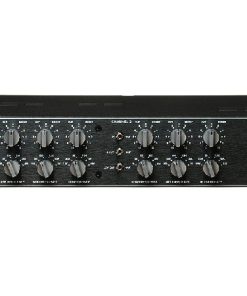SPL Volume 2 SPL
$ 499,00 $ 149,70
The Volume 2 is a fully analog active stereo volume controller and a puristic high-end preamplifier.
- High end volume potentiometer and illuminated mute switch from ALPS; the potentiometer controls signals directly (without VCA or DAC circuitry)
- The mute switch allows for very fast reaction times in cases where loud speakers or ears should be protected (for example, with computer crashes)
- In contrast to digital volume controls which reduce the bit resolution at lower listening levels there is no degration in sound with an analog volume control
- In contrast to passive volume controls which alter the phase and frequency response there is no alteration in sound with an active volume control
- Users of analog summing without monitoring facilities can cost effectively improve their systems
- High quality balancing stages with extremely good common mode rejection minimize interferences and disturbances in the signal paths
- Balanced XLR in- and outputs
- A high quality power supply with toroidal transformer
- Massive, 45 mm diameter aluminum knobs ensure consistent, refined handling
- The elegant, compact housing allows for flexible desktop positioning near or under a computer monitor.
- Made in Germany
Stereo Volume Controller
As a cost-effective alternative to our full-featured Stereo and Surround Monitoring Controllers MTC and SMC the Volume 2 focuses on the high quality in active volume control. Users who do not need additional monitoring functionality provided by the MTC will find the Volume 2 an cost-effective solution without compromises. The Volume 2‘s design is based on active switching to avoid nonlinear frequency response introduced by impedance changes with passive designs when changing levels.
The Volume Controller Volume 2 serves as a system-independent analog volume regulator in all areas of audio processing and playback, including
- Music production
- Movie and video post production
- Video computer games production
- Hi-fidelity applications
Analog Volume Control – Why?
The majority of D/A converters and sound cards provide nothing in the way of analog level control, and this means the necessity of varying signal levels at the converter outputs. The result is a lowered bit rate in the monitoring signal, which can lead to commensurate loss of audio quality.
Compared to passive volume controls which affect the frequency and phase response each time the volume is changed the active design of the Volume 2 is stable in phase and frequency, which is important to always be sure to monitor the same signal.
A further, very interesting application area is in the construction of a straight, audiophile-quality stereo playback chain, where the Volume2 is situated between the playback machine and either power amp and speakers or simply active speaker system. In such cases, the playback machine must offer analog outputs. This provides for minimal financial and electronic efforts through the most direct possible playback path.
Unbalanced connections, e. g. to and from RCA or TS Jack
You can establish unbalanced connections easily and without adaptors – for example from CD-Players with RCA outputs or to (HiFi) power amplifiers with RCA inputs. In any case we recommend to use readily configured cables from XLR to the respective RCA or TS/TRS connector to dispense with adaptors. Ask your dealer for configured cables. It is important to pay attention to the correct polarity of the three XLR wires. With the XLR pin configuration diagram in our manuals any audio expert can ensure to select or configure appropriate cables.
Prompt Delivery and Professional Packaging
Our long-standing partnership with UPS FedEx DHL and other global carriers lets us offer a range of shipping services. Our warehouse staff is extremely skilled and will package your items according to our precise and exact specifications. Your goods will undergo an extensive inspection and be safely packaged prior to being sent out. Each day, we ship to thousands of customers in many countries. The fact that we are committed to becoming the biggest online retailer in the World is clear. These warehouses are in Europe in the same way as they are in USA.
Note: Orders that include more than one item are assigned a processing period depending on the item.
Before shipping, we will inspect thoroughly the items you have ordered. Most orders are shipped within 48 hours. Expected delivery time is between 3-7 days.
Returns
Stock is dynamic. It's not entirely managed by us since we are involved with multiple entities, including the factory and the storage. The actual stock can change at any moment. It is possible that your order may be out of stock once the order has been placed.
Our policy lasts for 30 days. We cannot exchange or refund your order if it has been 30 days from the date of purchase.
For your item to be returned it must be in its original packaging, unopened and in the condition you received it. The item must be in its original packaging.
Related products
Recording Equipments
500 Series
Microphones
Equalizers
Accessories
Headphones
Microphones
Monitor
Recording Equipments
Microphones
Microphones
Accessories
Recording Equipments
Mic Preamp
Recording Equipments
Monitor Systems
Mic Preamp
Monitor Systems
500 Series
Equalizers
Monitor Systems
Accessories
Microphones
Microphones
500 Series
Monitor
Subwoofer
Accessories






























































